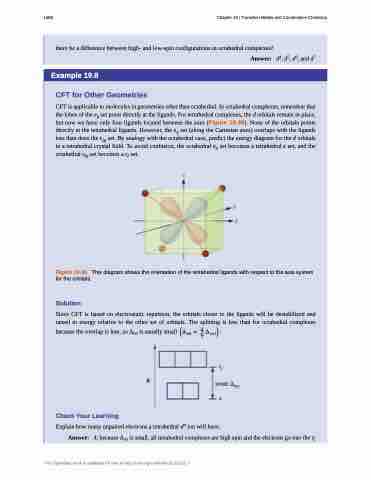Page 1096 - Chemistry--atom first
P. 1096
1086 Chapter 19 | Transition Metals and Coordination Chemistry
there be a difference between high- and low-spin configurations in octahedral complexes?
Answer: d4, d5, d6, and d7
Example 19.8
CFT for Other Geometries
CFT is applicable to molecules in geometries other than octahedral. In octahedral complexes, remember that the lobes of the eg set point directly at the ligands. For tetrahedral complexes, the d orbitals remain in place, but now we have only four ligands located between the axes (Figure 19.36). None of the orbitals points directly at the tetrahedral ligands. However, the eg set (along the Cartesian axes) overlaps with the ligands less than does the t2g set. By analogy with the octahedral case, predict the energy diagram for the d orbitals in a tetrahedral crystal field. To avoid confusion, the octahedral eg set becomes a tetrahedral e set, and the octahedral t2g set becomes a t2 set.
Figure 19.36 This diagram shows the orientation of the tetrahedral ligands with respect to the axis system for the orbitals.
Solution
Since CFT is based on electrostatic repulsion, the orbitals closer to the ligands will be destabilized and raised in energy relative to the other set of orbitals. The splitting is less than for octahedral complexes
because the overlap is less, so Δtet is usually small ������ � �� ������ �
Check Your Learning
Explain how many unpaired electrons a tetrahedral d4 ion will have.
Answer: 4; because Δtet is small, all tetrahedral complexes are high spin and the electrons go into the t2
This OpenStax book is available for free at http://cnx.org/content/col12012/1.7


